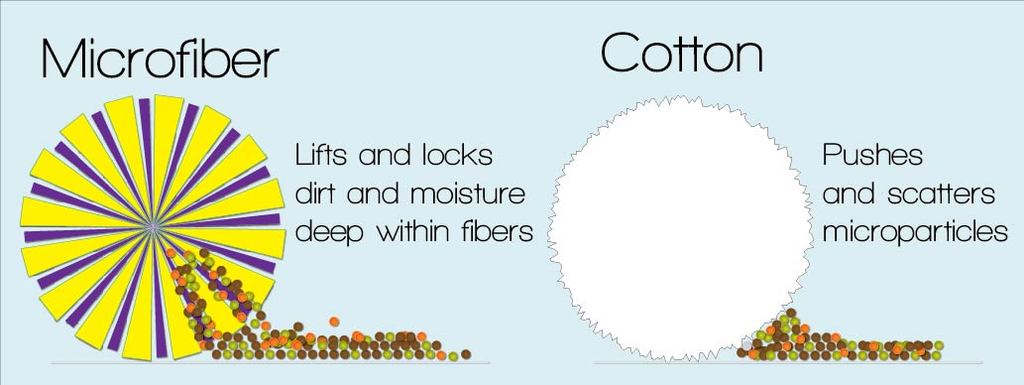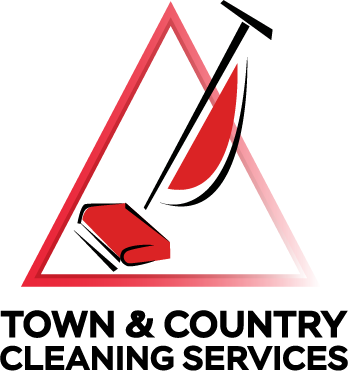Microfiber Cleaning Cloths: What, Where, and How
The advent of microfiber to the cleaning industry has been the greatest revolution since the introduction of detergents in the 1950s. Microfiber cleaning cloths and mops allow us to clean with less water and harsh chemicals. They also happen to do a better job at the same time. But what are microfibers and how do we use them properly?
What are microfibers?
Microfibers are very thin fibers, about 1/16th the thickness of a human hair, made from a combination of polyester and nylon. These fibers are then spilt so that each fiber has many little fissures around it. Microfibers can be woven into cloths, mops, or dusters. The quality of the product will be determined by the density of the fibers, the tightness of the weave, and how well the fibers are split. Some microfiber cleaning cloths and mops have a bacteriostat built into them to prevent the growth of microbes on the fabric.
Microfiber cleaning cloths come in a wide variety of qualities and types. Some are too aggressive to use for dusting fine furniture. Others have microfiber on one side and a nylon scrub surface on the other. There are also microfiber cloths designed specially for cleaning glass. Microfiber mops also come in a variety of configurations depending on the intended use. The quality of the microfiber cloth or mop will also determine how long they will last
How do microfiber cleaning cloths work?

In the above picture you can see a comparison of a microfiber and a cotton fiber. The microfiber scoops up soil and bacteria while the cotton, which is much larger, tends to roll over the soils. As the microfibers are passed over a surface, static electricity will pull soil up into these fissures if the cloth or mop is dry. If the microfiber cloth or mop is dampened then the soils are lifted by capillary action. Microfiber products do not work well if they are soaking wet. The excess moisture fills in the fissures, leaving no room for soils.
Why use microfiber cleaning cloths?
The simple answer is they work! According to a study at the University of California – Davis, microfibers were able to remove 99% of soil and bacteria from a hard surface using only water compared with 33% for cotton. The microfibers used in this test were considered mid-grade.
Some microfiber cloths, such as the hospital grade PerfectClean cloths we use, have third party lab testing showing a removal of 99.99% and is some cases as much as 99.9999% removal depending on the pathogen. Again, using just water with the microfiber. It is important to remember that this result matches the effects of disinfectants without the use of toxic chemicals.
We also should note that the cloths are removing, not killing, pathogens. Therefore proper laundering is critical. Some, such as the PerfectClean cloths we use, have built in a bacteriostat to prevent additional microbial growth on the cloths or mops. For more information, the PerfectClean website has some great resources available. As mentioned earlier, these cloths are too aggressive for dusting fine furniture. For dusting, we use a softer grade of cleaning cloth.
How to use microfiber cleaning cloths
As stated above, microfibers work best dry or damp. They will work well for most general cleaning with just water. For heavy, greasy build ups or hard water deposits additional cleaning solutions will be necessary.
Fold your cloth in quarters; this gives you 8 sides for cleaning. Next, pre spray the area to be cleaned. Then you use your dry microfiber cloth to pick up the dirty solution. As you use the cloth, keep turning to a fresh side. Once the fibers fill up it stops working. At that point grab a fresh cloth, fold in quarters, and continue cleaning. Microfiber mops also have to be rinsed or changed as they fill up.
You can use different color microfiber cloths and mops for kitchen and bath to prevent cross contamination. Normally there is no need in household cleaning to follow with a disinfectant. However, in the current pandemic, or if there is a serious disease outbreak in your home, disinfecting touch points is a reasonable precaution.
How to care for microfiber cleaning cloths
A quality microfiber cloth or mop should last thru 100 to 300 washes if it is cared for properly. Wash microfiber products separately from other textiles in hot water. Fibers shed by cotton and other fabrics can clog the tiny fissures that make microfibers work. Do not use fabric softener as this will also clog up the fissures in the fiber. Most microfibers can take water temperature up to 180 to 200 degrees. However, dry heat can melt the fibers. Microfiber cloths should be air dried or dried on a low setting.
PerfectClean also says that how you are using the cloth matters. Heavier cleaning jobs may wear down cloths a bit quicker. Regular household cleaning applications are fine. However, if you are doing jobs such as cleaning food equipment, you may find your cloths don’t last quite as long.
Chlorine bleach is not recommended. Higher quality microfiber cloths will take it, but it will shorten their life. Still, it might be worth using if you have been cleaning something with a high biological risk. If you aren’t already using them, this might be a good time to give microfibers a try. Any questions? Give us a call.

